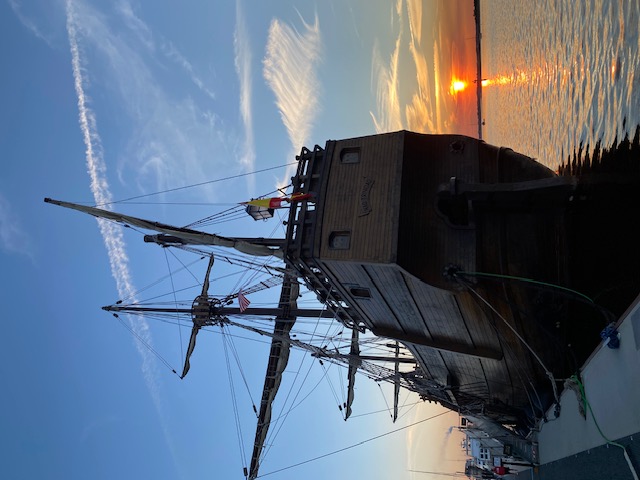
By Wilma Allen
Today is your last chance to step back in time and imagine life aboard a remarkable ship that made what is considered the greatest journey in maritime history.
Moored at our downtown marina is a full-scale replica of Nao Trinidad, the flagship in the historic expedition of Ferdinand Magellan, the first ever to circle the globe. This incredible three-year voyage began more than 500 years ago in 1519, almost three hundred years before Fernandina Beach even had a name.
With a main mast 85 feet high, today’s Nao Trinidad towers over sailboats, yachts, and sportfishing boats in the harbor, but it is only as wide as three shipping containers and less than half the length of a football field. Roughly the size of a three-bedroom house, it was a workplace and home for about 40 sailors at a time, many of whom lost their lives on the mission.
With no heat, refrigeration, GPS or wi-fi, seamen struggled round the clock to keep the ship afloat and moving. They lived, worked, ate and slept aboard for months into years while the wooden ship shuddered and rolled against the waves, and wind and rains whipped at the sails. The crew slept crammed together, whatever the weather, on limp mats, rolled out on slanting open decks. Leisure time did not exist. Only the captain had his own cabin and moments of privacy. Disease, discontent, and disappointment ran rampant. Sometimes, there was little more to eat than stale, wormy biscuits, rats, and sawdust.
Magellan’s incredible voyage was a high point of Europe’s so-called “Age of Discovery.” It connected continents and oceans, opened lucrative trade routes, and bolstered Europe’s dominance of people and cultures around the world.
With just compasses, quadrants, lines and charts, Magellan sailed his Nao Trinidad from Spain, across the Atlantic, around the tip of South America, and across the Pacific to what is now called Indonesia, before storms beat it down. Its sister-ship, Nao Victoria, continued the journey around Africa’s Cape of Good Hope and back to Spain.
Magellan’s voyage might be equivalent to SpaceX’s hoped-for mission to Mars by today’s standards.
Sometime tomorrow, Nao Trinidad’s replica will pull up ladders and anchor, and motor down the Amelia River past giant container ships, factories and Fort Clinch. Once at sea, it may unfurl its sails, a thrill for the paid and volunteer crew and those lucky enough to catch a glimpse from the shore. Then the sails come down, the motor churns, and the tall ship lumbers into St. Augustine, the next port-of-call on its own inspiring, remarkable journey. If you missed it, head to St. Augustine before March 31, or visit the website, www.naotrinidad.org.
